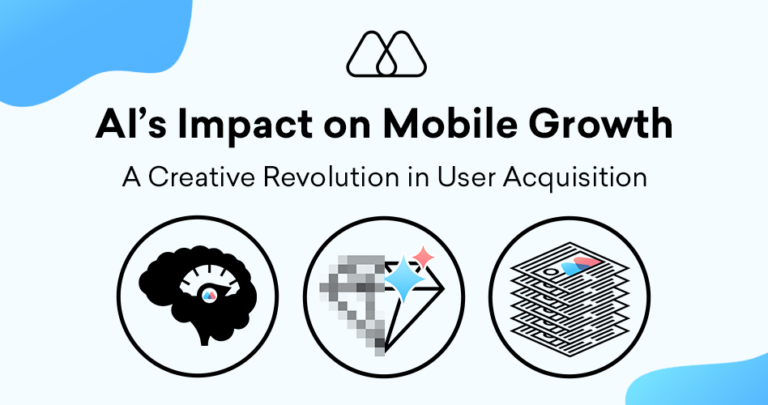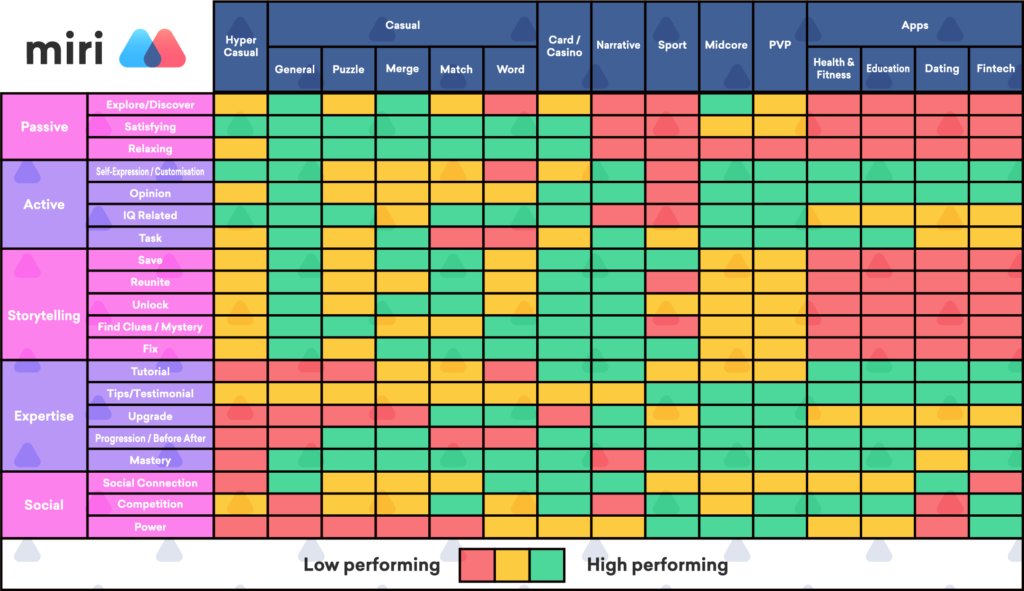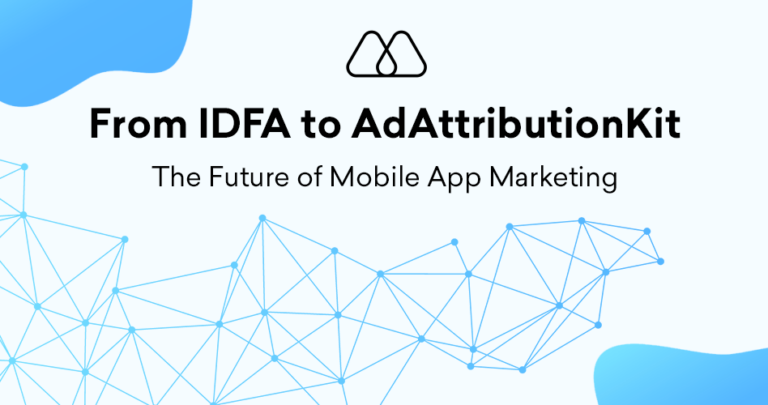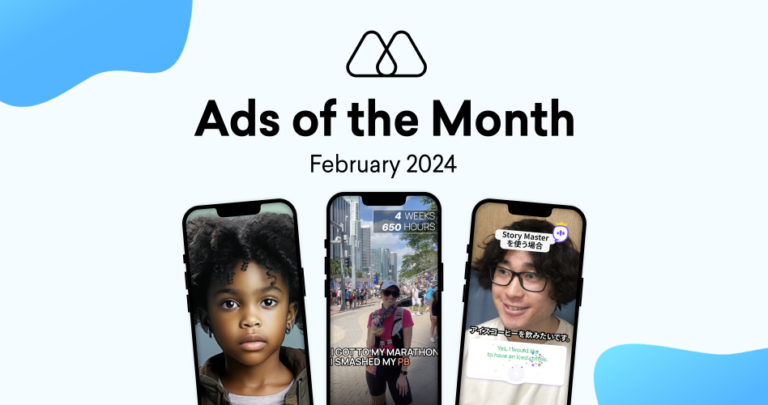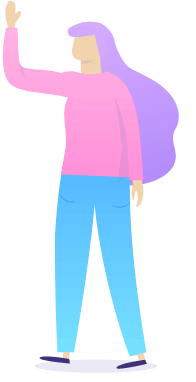The mobile app industry is ever-evolving, with millions of apps vying for user attention in an ever-crowded marketplace. In this fierce competition, user acquisition (UA) has become the lifeblood of app success. At the same time, traditional UA strategies have matured and, whilst effective, are constantly put under pressure to deliver a return on ad spend (ROAS) whilst dealing with competitor copycat tactics and fighting to catch a shorter attention span. We’re forced to produce more creatives that stand out from the crowd – and to produce them faster.
This is where Generative Artificial Intelligence (gen-AI) emerges as a powerful tool to have at your disposal. At this point in time, that’s exactly how we see gen-AI – as a tool that can allow us to ideate and execute with a different style. It’s also important to remember that AI ≠ Automation and we often have to be creative about how we use different tools to make sure we’re not just bloating an already convoluted production process.
AI injects a blend of speed, quality, and quantity into UA and Creative. It empowers marketers to generate data-driven creative concepts rapidly, remove human bias from decision-making, and unlock hidden insights from vast competitive datasets. It still feels like we’re only scratching the surface of the potential impact that gen-AI will have on mobile growth, and we’re excited about what the future holds.
AI's Three-Pronged Impact on UA Creative
AI’s impact on mobile growth can be deconstructed into three key dimensions:
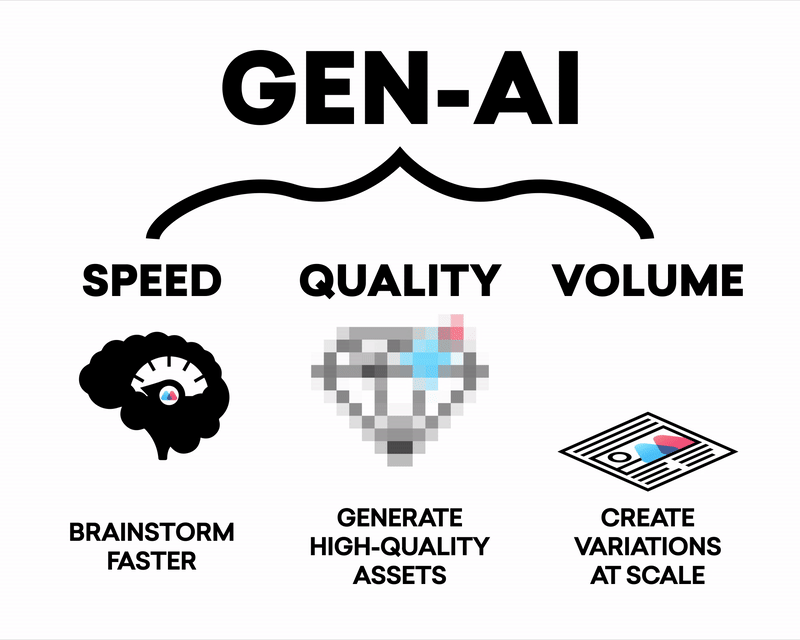
- Speed: Imagine generating a multitude of creative concepts for your next creative batch in a matter of hours, not weeks. AI-powered ideation processes can be the best brainstorming technique to efficiently populate your creative roadmap and help you get out of a creative rut. Compile all of your assumptions on user demographics, app usage patterns, trending topics, and even successful competitor ad elements to map out unique creative concepts. This allows for rapid A/B testing of different creative variations, accelerating the optimization process and helping you identify winning ad formats and messaging much faster.
- Quality: Producing a quality concept requires the right assets, in high definition, and in the right style. Creating a new asset for your creative concept takes time, and sometimes stock assets just don’t make the cut – finding the asset that fits the unique art style and branding can be a painful experience. Gen-AI can help you visualise and execute on individual assets to use in your creative and upscale your existing assets to ensure versatile use cases.
- Volume: Rapid A/B testing of creative at scale is vital for delivering insights and finding new creative winners. Gen-AI enables a high volume of variation and iterative production – variations to change a single variable (copy, VO accent, background) and iterations to explore tangents to a creative (script, theme/style, palette). It’s important to remember that volume shouldn’t be produced just for the sake of volume – and a key role of a creative strategist is to prioritize what’s best to test.
Main Use Cases For AI In UA & Creative
As the hype around AI development has taken over the past year, we’ve seen more and more tools released, and it can often get overwhelming. Often, a newly released tool is simply a combination of already existing technologies, and we’ve found the highest impact when we break it down to find unique use cases and build them around our internal processes. It’s often a process of trial and error. Below, we’ve identified five areas where AI will or has already impacted our UA & Creative processes.

Generative Ideas:
- Brainstorming and Inspiration: Generate creative concepts, ad copy variations, scripts, or slogans.
- Keyword Research and Competitor Analysis: Identify relevant keywords and analyze competitor strategies.
- Audience Analysis: Utilize AI-powered tools to understand your target audience better, what motivates them and what their cultural preferences are
Generative Assets:
- Image and Video Creation: Generate images, videos, and animations based on text prompts or specific styles.
- Music Composition and Sound Design: Create background music, sound effects, and audio elements.
- VO: Generate voice overs representative of various demographics and languages.
- AI-UGC: Generate humanlike avatars paired with VO to create compelling UGC-inspired concepts.
- 3D Modeling and Character Design: Develop 3D models and realistic avatars for various applications.
Generative Insights:
- Data Analysis and Reporting: Analyze large datasets, identify trends, and generate reports.
- Predictive Analytics: Forecast future performance and optimize campaign strategies.
- Automation of Repetitive Tasks: Automate tasks like data entry, scheduling, and content tagging.
Competitive Analysis:
- Identify Top Performing Ads: Analyze competitor ad campaigns and identify successful strategies.
- Deconstruct Competitor Ads: Understand the elements contributing to competitor ad success.
- Generate Storyboards and Benchmarks: Create storyboards based on competitor ads and performance benchmarks.
Creative Strategy:
- Ad Iteration and Optimization: Generate multiple ad variations for A/B testing and optimize performance.
- Automated Creative Tasks: Automate tasks like image tagging, caption generation, and content categorization.
The Creative Matrix: A Framework for AI-Fueled Creativity
Many UA teams utilize the creative matrix – a strategic framework that maps user personas against various messaging approaches and creative formats (video ads, statics, etc.). This can be used as a tool for idea generation as well as creative analysis. Gen-AI can elevate this framework by injecting a new level of sophistication and efficiency.
- AI-Generated Creative Concepts: Gone are the days of limited creative options. AI can help populate the creative matrix with a broader spectrum of messaging and format variations based on your test data and market trends. This allows you to test a wider range of creative combinations and discover unexpected high-performing options.
- AI-Generated Creative Variations: Once top-performing concepts have been found, gen-AI can be used to assist in suggesting different variations, be that on which variables to iterate on, as well as specifically what variations to make. Combined with concept templating, this can become powerful for efficient creative refreshes.
- Persona Identification: AI algorithms can analyze user data and behavior to automatically segment users into relevant personas. This eliminates manual segmentation efforts and ensures your targeting aligns with actual user profiles.
- Predictive Performance: Once performance data is available, AI can analyze historical results and campaign performance to predict the potential effectiveness of different creative combinations within the matrix. This allows for a more data-driven approach to creative selection, maximizing your chances of success from the get-go, as well as a more intentional creative strategy.
AI and Creativity: A Collaborative Future, Not a Replacement
There’s a concern that AI might replace or reduce the need for human creativity in mobile UA, but I believe this is unfounded. AI is a powerful collaborator, not a competitor, to human creative teams and a key part of human creativity that’s lacking in AI is intentional out-of-the-box thinking. Give AI some steer and you’ll get some value, ask for something different and you’ll get something fresh, but try that multiple times with the same question and you’ll get similar results.
AI as a Creative Liberator
- Frees Up Time for Strategic Thinking: By adding efficiencies to tasks like brainstorming and A/B testing variations, AI frees up valuable time for human creatives to focus on higher-level strategic thinking. This allows them to develop the core brand narrative, craft compelling storytelling elements, and inject emotional resonance into creatives.
- Enhanced Creative Exploration: AI can generate a broader range of creative concepts than humans might envision on their own in a shorter time frame. This allows for exploration of unexpected avenues and the potential discovery of high-performing execution or messaging approaches that might have been overlooked.
- Alternative Execution Styles: gen-AI is a style in and of itself, and this opens more doors than it closes. Taking advantage of an uncanny-valley avatar, outrageously enthusiastic voice-overs and hyper-detailed and dream-like assets can add variety to a designer’s asset bank, and be part of unique concepts as a result.
- Data-Driven Inspiration: Human creativity thrives on inspiration. AI provides a treasure trove of data insights that can spark new creative ideas. Analyzing user behavior patterns, competitor ad strategies, and even social media trends can ignite the creative spark and lead to the development of truly original and engaging concepts.
Human Expertise Remains Crucial
While AI is a powerful tool, it cannot replicate the intangible aspects of human creativity:
- Emotional Storytelling: Evoking emotions in target audiences is a core element of successful advertising. Human creativity excels at crafting narratives, injecting humor, and creating a sense of connection with viewers, something AI currently struggles to replicate.
- The “X-Factor”: Sometimes, the most successful creatives have an undefinable “X-factor” – an originality or emotional resonance that defies analysis. This is where human intuition and creative spark come into play.
- Out-of-the-box Thinking: Other times, the most successful concepts come from pushing an idea to its limit and thinking outside of the box – taking risks on an idea you believe in. This is something that can’t be summarised into a prompt.
- Understanding Brand Voice: AI can analyze data on brand messaging, but it doesn’t possess the deep understanding of a brand’s unique voice and personality that human creatives bring to the table.
User Acquisition Managers Can Lighten the Creative Load
Beyond core creative teams, user acquisition managers can also leverage AI to streamline their workflows and contribute to creative iterations. Here’s how:
- Testing Variations of Winning Concepts: Once a high-performing creative concept has been identified, UA managers can use it as a foundation and brainstorm variations in messaging, visuals, or CTAs to test for further optimization and produce the corresponding creative thus removing the workload from the creative team so they can focus on new concept ideation.
- A/B Testing with AI Recommendations: AI can analyze user data and past campaign performance to recommend specific elements within winning creative concepts that can be A/B tested for further improvement.
Evolving Landscape: Challenges and Ethical Considerations
While AI offers a world of exciting potential, it’s important to acknowledge current challenges and ethical considerations:
- Data Privacy Concerns: User data is the fuel driving gen-AI tools. However, ensuring user privacy and adhering to data regulations remains paramount. Companies must be transparent about data collection practices, obtain explicit user consent, and implement robust security measures to protect user information.
- Bias in Training Data: AI algorithms can perpetuate biases present in the data they are trained on. For instance, if an AI tool is trained on a dataset with an overrepresentation of a specific demographic, it might generate creative concepts that resonate less effectively with other user segments. Mitigating bias requires using diverse datasets, employing human oversight in the training process, and continuously monitoring AI outputs for potential bias.
- Explainability and Transparency: As AI models become more complex, understanding how they arrive at specific recommendations can be challenging. This lack of transparency can raise concerns about accountability and make it difficult to optimize outputs effectively. The industry needs to move towards developing more “explainable AI” solutions that provide users with a clear understanding of the reasoning behind AI-generated recommendations.
- Areas of potential legal exposure when using generative AI: Original Character design (Copyright or Trademark Infringement), Localization (non-human verified), Music, Voices (if mimicking actors), Mimicking Art Styles Of Artists, Logo Design, Slogans, Long-Term Brand Assets
- Less controversial uses of generative AI: Competitive Research, AI Voiceover, AI Captions, AI Avatars, Creative Concept Ideas, Generative Background Fill, AI Sound Effects, 3D from 2D Images, Parallax Effects, Gameplay Capture, Ad Creative Tagging, Upscaling Assets, A/B Testing Plans, Dynamic Content Generation, In-App Tutorial Generation, Sentiment Analysis From User Reviews
Conclusions
The integration of AI into mobile UA strategies is no longer a question of “if” but “how”. By embracing AI as a collaborative partner, mobile app marketers can unlock new levels of campaign effectiveness.
The future of mobile app advertising lies in a powerful collaboration between human creativity and AI capabilities. By leveraging AI’s data-driven insights and creative exploration potential, human creatives can focus on the strategic and emotional aspects of advertising, ultimately leading to the development of more impactful and successful mobile app user acquisition campaigns.
5 Key Takeaways
- AI injects speed, quality, and volume into the UA process: AI empowers rapid creative ideation, removes human bias from decision-making, and uncovers hidden insights from vast datasets.
- The Creative Matrix gets a boost from AI: AI can identify user persona groups, generate a wider range of creative variations, and help predict the potential performance of different ad combinations.
- AI and human creativity are a powerful duo: AI frees up human creatives for strategic thinking and emotional storytelling, while human expertise remains crucial for understanding brand voice and crafting impactful narratives.
- User acquisition managers can leverage AI: UA managers can use AI recommendations for A/B testing variations of winning concepts and optimize creative elements based on data insights.
It’s just the beginning: As new tools continue to come to market and ethical and legal concerns get addressed, we’ll find more use cases where AI can help UA and Creative teams unlock performance
